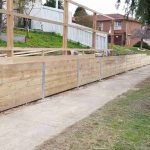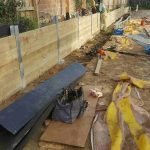Introduction
When it pertains to landscaping, among the most crucial features you might think about is a retaining wall. These structures not just serve a functional purpose however also enhance the aesthetic appeal of your home. Keeping walls can prevent soil disintegration, manage water drainage, https://tuffstuffretainingwalls.com.au/ and develop flat locations in sloped gardens. However when it's time to install one, you may wonder whether to take on the project yourself or employ a professional maintaining wall installer.
The choice between do it yourself and hiring a retaining wall contractor can be intimidating. This post breaks down the DIY vs. Expert Retaining Wall Installation: Pros and Cons to help you make an informed decision. We will explore numerous elements, including expenses, products, abilities needed, and much more. So grab a cup of coffee as we delve into this critical topic.
DIY vs. Expert Retaining Wall Installation: Pros and Cons
Understanding Keeping Walls
What Is a Keeping Wall?
A maintaining wall is a structure developed to hold back soil or rock from a structure or location. They are available in numerous materials such as concrete sleeper blocks, wood sleeper panels, H beams, and stone masonry.
Why Are Retaining Walls Important?
Retaining walls serve multiple purposes:
- They assistance manage water flow. They avoid soil erosion. They create functional land in sloped areas.
Types of Retaining Walls
Concrete Sleeper Walls
Concrete sleeper walls are popular for their toughness and strength. They are frequently used in industrial tasks due to their capability to withstand heavy loads.
H Beam Walls
H beam walls make use of steel beams that offer excellent assistance for bigger structures and are commonly utilized in commercial applications.
Wood Sleeper Walls
Wood sleeper walls provide a visual appeal that blends well with natural landscapes but might not last as long as concrete options.
Timber Sleeper Walls
Timber sleeper walls are another attractive choice but need regular upkeep to make sure longevity against rot and pests.
Materials Used for Maintaining Walls
Stone
Stone is a classic material that adds elegance but can be costly and labor-intensive.
Concrete Blocks
These are flexible and cost-effective but may do not have visual appeal unless completed properly.
Pros of DIY Retaining Wall Installation
Cost Savings
One of the main benefits of DIY setup is conserving cash on labor costs associated with hiring a retaining wall builder or specialist. You're basically paying only for materials.
Flexibility in Design
When you go the do it yourself route, you have complete control over the style aspects-- how high you desire it, what materials to use, etc
Skill Development
Taking on the project yourself allows you to find out new abilities like masonry or landscaping strategies which can be helpful in future home improvements.
Immediate Availability
If you're eager to get started on your landscape job, doing it yourself implies no lingering for a contractor's schedule to open up.
Cons of do it yourself Retaining Wall Installation
Time-Consuming Process
Even though do it yourself jobs appear appealing due to cost savings, they can take considerably longer than anticipated-- specifically if you're inexperienced.
Lack of Expertise
If you've never ever constructed a maintaining wall before, errors can happen easily-- leading to structural failures that might cost much more down the line.
Limited Devices Access
Professional contractors have access to customized equipment that might not be readily available for do it yourself lovers which can make tasks more difficult than anticipated.
Pros of Employing an Expert Retaining Wall Installer
Experience and Expertise
Professional maintaining wall specialists bring years of experience which significantly decreases the threat of mistakes during building and construction.
Quality Assurance
Hiring a specialist often guarantees greater quality work because they adhere strictly to industry standards.
Time Efficiency
A professional team can finish tasks quicker than most homeowners merely because they work more efficiently with practiced methods.
Access to Quality Materials
Contractors usually have relationships with providers providing them discounts on quality products like concrete sleepers or wood sleepers that you may not access as easily on your own.
Cons of Employing an Expert Retaining Wall Contractor
Higher Expenses Involved
While hiring specialists brings numerous benefits, it likewise comes at a premium price compared to doing it yourself which might deter some property owners from going this route.
Less Control Over Design Choices
When dealing with contractors, you may have less flexibility relating to design choices given that they generally follow their proposed strategies unless otherwise specified.
FAQs
1. What aspects ought to I think about when choosing in between DIY and working with a professional?
Consider your budget, skill level, time constraints, and the intricacy of the task. If you're unsure about any aspect or absence experience with keeping walls like concrete sleeper installation, it's much better to employ an expert.
2. How much does it generally cost for professional installation?
Expenses differ widely based upon materials used (like H beams or wood sleepers) and local labor rates; nevertheless, anticipate anywhere from $15-$50 per square foot depending on these variables!
3. Can I utilize different kinds of materials together?
Yes! Mixing products such as stone bases with timber or concrete tops can produce an aesthetically pleasing appearance while maintaining structural stability-- but consult with specialists first if unclear about compatibility!
4. What sort of drainage must I include in my design?
Correct drain is important! Ensure your design includes weep holes or gravel backfill behind the wall so water does not build up versus it-- which might cause failure over time!
5. Is planning permission needed for constructing keeping walls?
In numerous locations yes; it's best practice (and sometimes lawfully needed) check regional zoning laws before starting any building and construction-- especially taller structures!
6. How do I maintain my freshly installed maintaining wall?
Regular inspections are key! Look out for cracks or indications of moving; cleansing particles regularly will also lengthen life expectancy-- especially important if utilizing lumber due its vulnerability against rot!

Conclusion
Choosing between DIY vs. professional maintaining wall installation eventually boils down to your private circumstances-- budget restraints versus ability level being perhaps the most significant factors at play here!
Whether you choose employing a skilled specialist who focuses on setting up things like concrete sleepers or opting for hands-on labor tackling wood sleeper designs yourself-- the right choice depends totally upon what feels finest matched towards attaining those landscaping dreams efficiently!
By considering all pros & & cons highlighted above concerning both approaches discussed within this short article-- you'll find yourselves equipped much better than ever before making decisions confidently moving forward into whatever backyard endeavors await ahead!
